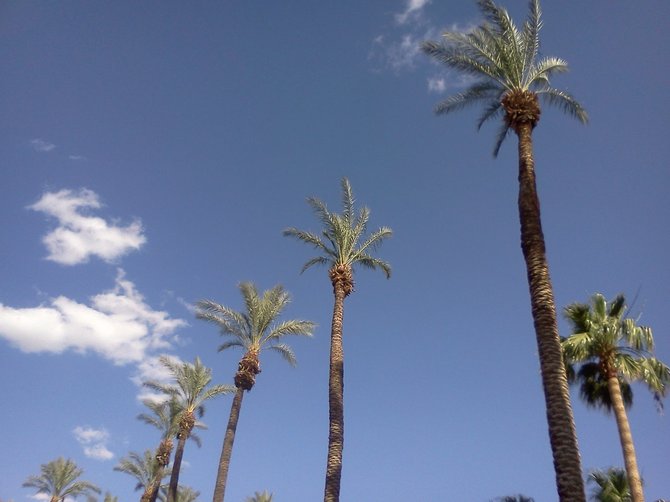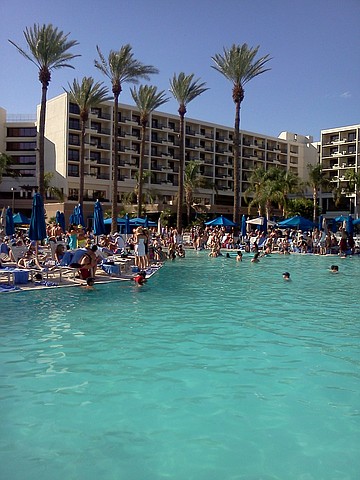 Facebook
Facebook
 X
X
 Instagram
Instagram
 TikTok
TikTok
 Youtube
Youtube

“It's like everyone is on a vacation. An extra pep is in the air.”
This statement came from an acquaintance of mine who opened up a restaurant in Palm Desert. His customers continually wore smiles and carried a “no-worries” attitude. And his paradise rests only about two hours away from San Diego. I immediately realized that a road trip was in order.
But then again, it doesn’t take much to get me on a road trip. I love the journey for just that – the journey. Cruising north on the I-15 to Temecula flew by in a flash while absorbing the excitement of an upcoming destination weekend. But then State Route 79 came up. What? Get off a main interstate to get to Palm Desert?
Growing up in L.A. and Orange County, I'd visited the area numerous times via the concrete jungle of the 91 Freeway and I-10.
Now, from San Diego, State Routes 79, 371 and 74 carve inland through the rolling landscapes of Indian reservations and state parks separating occasional block towns (as in, only a few blocks makes the town). The driver is taken through, over and around a mountain range, at some points climbing 4,000 feet of boulders reminiscent of Utah or Arizona’s mini-monoliths. At other times one might believe they were traveling the inland route to Ensenada, away from civilization.
My mind ran with, “Am I really headed to Palm Desert?” Yes, the road trip had won me over – I already knew this excursion would be made again. But even before making the trip from San Diego, I’d already kept fond Palm Desert memories. Australia, strangely, allowed me to quantify this a few years back:
It was my first week living in Sydney. I had no job or permanent place to call home, but I did have the lower half of a hostel’s bunk bed, heaps of excitement and a novel I'd just found in a used bookshop. Its story involved two friends driving out to Palm Springs from Los Angeles.
I couldn’t stop my hands from grabbing it for two reasons: 1) I felt the attachment boiling within me similar to when I saw the classic movie Swingers, and 2) at that moment I fully grasped how lucky I was to have grown up experiencing these missions myself.
But back to Palm Desert. Or is it Palm Springs? Well both…sort of. “Palm Springs” usually refers to the Coachella Valley, comprised of nine fairly unique cities. Palm Springs and Palm Desert are both cities within this valley. Originally inhabited by Cahuilla Indian farmers, it then served as training grounds for General George Patton’s Third Army. After World War II, a Los Angeles developer began to develop the Palm Desert area into his vision of a dream community.
To differentiate in more modern terms, Palm Desert is the place where spring break jolts the town for a few weeks a year. It’s where Jerry, the bartender at the Embassy Suites, was known to serve underage high school kids (I may have been tight with Jerry back then). It’s the community with major resorts – seriously major resorts.
Take the JW Marriott Desert Springs Resort and Spa, covering 400 acres of land. Links Magazine ranks it in the top 20 golf resorts of California with its 36 holes of play. An actual network of waterways navigable by gondolas beckons guests who want to glide to dinner or charter a joyride on.

One of Palm Desert’s premier nighttime spots is here at Costas. Not looking for nighttime festivities? That’s OK, because the resort features a day pool-party reminiscent of San Diego’s own Intervention or Las Vegas’ Rehab. One can stay in a resort like this and never have an urge to go farther.
But with over 100 golf courses in a ten-mile radius, a golfer might want to go farther. With the El Paseo Shopping District featuring over 300 world-class shops, restaurants and art galleries, a wide range of visitors might want to go farther. And with numerous trails cutting through the area, those looking to hike, bike or ride horses should definitely look into going farther.
Palm Desert is a retreat catering to virtually whatever your heart desires.


“It's like everyone is on a vacation. An extra pep is in the air.”
This statement came from an acquaintance of mine who opened up a restaurant in Palm Desert. His customers continually wore smiles and carried a “no-worries” attitude. And his paradise rests only about two hours away from San Diego. I immediately realized that a road trip was in order.
But then again, it doesn’t take much to get me on a road trip. I love the journey for just that – the journey. Cruising north on the I-15 to Temecula flew by in a flash while absorbing the excitement of an upcoming destination weekend. But then State Route 79 came up. What? Get off a main interstate to get to Palm Desert?
Growing up in L.A. and Orange County, I'd visited the area numerous times via the concrete jungle of the 91 Freeway and I-10.
Now, from San Diego, State Routes 79, 371 and 74 carve inland through the rolling landscapes of Indian reservations and state parks separating occasional block towns (as in, only a few blocks makes the town). The driver is taken through, over and around a mountain range, at some points climbing 4,000 feet of boulders reminiscent of Utah or Arizona’s mini-monoliths. At other times one might believe they were traveling the inland route to Ensenada, away from civilization.
My mind ran with, “Am I really headed to Palm Desert?” Yes, the road trip had won me over – I already knew this excursion would be made again. But even before making the trip from San Diego, I’d already kept fond Palm Desert memories. Australia, strangely, allowed me to quantify this a few years back:
It was my first week living in Sydney. I had no job or permanent place to call home, but I did have the lower half of a hostel’s bunk bed, heaps of excitement and a novel I'd just found in a used bookshop. Its story involved two friends driving out to Palm Springs from Los Angeles.
I couldn’t stop my hands from grabbing it for two reasons: 1) I felt the attachment boiling within me similar to when I saw the classic movie Swingers, and 2) at that moment I fully grasped how lucky I was to have grown up experiencing these missions myself.
But back to Palm Desert. Or is it Palm Springs? Well both…sort of. “Palm Springs” usually refers to the Coachella Valley, comprised of nine fairly unique cities. Palm Springs and Palm Desert are both cities within this valley. Originally inhabited by Cahuilla Indian farmers, it then served as training grounds for General George Patton’s Third Army. After World War II, a Los Angeles developer began to develop the Palm Desert area into his vision of a dream community.
To differentiate in more modern terms, Palm Desert is the place where spring break jolts the town for a few weeks a year. It’s where Jerry, the bartender at the Embassy Suites, was known to serve underage high school kids (I may have been tight with Jerry back then). It’s the community with major resorts – seriously major resorts.
Take the JW Marriott Desert Springs Resort and Spa, covering 400 acres of land. Links Magazine ranks it in the top 20 golf resorts of California with its 36 holes of play. An actual network of waterways navigable by gondolas beckons guests who want to glide to dinner or charter a joyride on.

One of Palm Desert’s premier nighttime spots is here at Costas. Not looking for nighttime festivities? That’s OK, because the resort features a day pool-party reminiscent of San Diego’s own Intervention or Las Vegas’ Rehab. One can stay in a resort like this and never have an urge to go farther.
But with over 100 golf courses in a ten-mile radius, a golfer might want to go farther. With the El Paseo Shopping District featuring over 300 world-class shops, restaurants and art galleries, a wide range of visitors might want to go farther. And with numerous trails cutting through the area, those looking to hike, bike or ride horses should definitely look into going farther.
Palm Desert is a retreat catering to virtually whatever your heart desires.
Comments